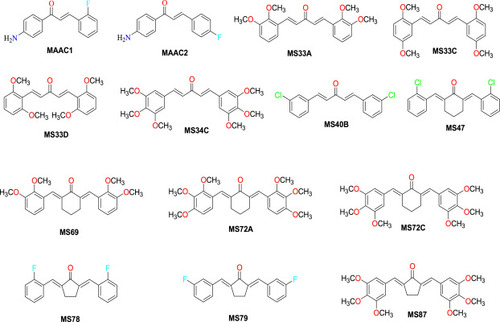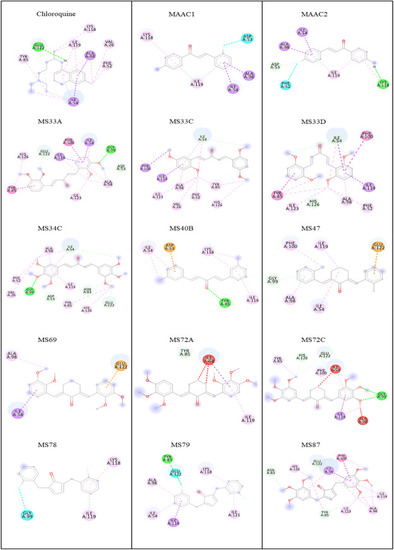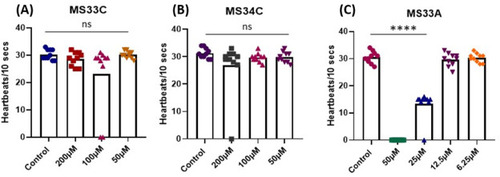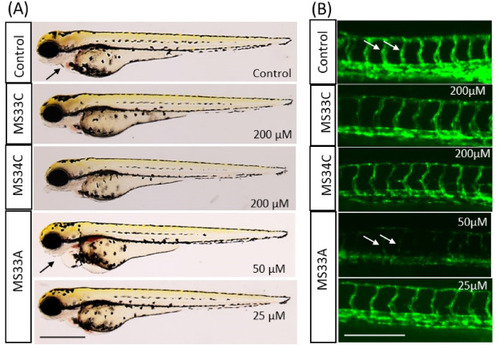- Title
-
Preliminary insight on diarylpentanoids as potential antimalarials: In silico, in vitro pLDH and in vivo zebrafish toxicity assessment
- Authors
- Ramli, A.H., Swain, P., Mohd Fahmi, M.S.A., Abas, F., Leong, S.W., Tejo, B.A., Shaari, K., Ali, A.H., Agustar, H.K., Awang, R., Ng, Y.L., Lau, Y.L., Md Razali, M.A., Mastuki, S.N., Mohmad Misnan, N., Mohd Faudzi, S.M., Kim, C.H.
- Source
- Full text @ Heliyon
|
Collection of diarylpentanoid analogues and derivatives categorized into differemt series: Series 1 (3-hydroxy-1,5-diphenylpenta-2,4-dien-1-ones), series 2 (3-benzylidene-2-hydroxycyclohexenyl)phenylmethanones), series 3 (2-styryl-4H-chromen-4-ones), series 4 (1,5-diphenylpenta-1,4-dien-3-ones), series 5 (2,5-di(benzylidene)cyclopentan-1-ones), series 6 (2,6-di(benzylidene)cyclohexan-1-ones), series 7 (1,5-diphenylpenta-2,4-dien-1-ones), series 8 (1-(3-phenyl-5-styryl-4,5-dihydro-1H-pyrazol-1-yl)ethanones), series 9 (chalcones), series 10 (N-(3-(5-phenylpenta-2,4-dienoyl)phenyl)benzenesulfonamides), series 11 (5-phenyl-3-styryl-1H-pyrazoles), and series 12 ((2,3-dihydro-1H-xanthen-4-yl)phenylmethanones). |
|
The selected diarylpentanoid analogues and derivatives with the highest and lowest binding energy against PfLDH (PDB ID: 1CET) from molecular docking studies. MAAC1 [(4-Amino-phenyl)-3-(2-fluoro-phenyl)-propenone; −6.7 kcal/mol], MAAC2 [(4-amino-phenyl)-3-(4-fluoro-phenyl)-propenone; −6.8 kcal/mol], MS33A [1,5-bis(2,3-dimethoxyphenyl)penta-1,4-dien-3-one; −5.8 kcal/mol], MS33C [1,5-bis(2,5-dimethoxyphenyl)penta-1,4-dien-3-one; −5.6 kcal/mol], MS33D [1,5-bis(2,6-dimethoxyphenyl)penta-1,4-dien-3-one; −5.5 kcal/mol], MS34C [1,5-bis(3,4,5-trimethoxyphenyl)penta-1,4-dien-3-one; −5.8 kcal/mol], MS40B [1,5-bis(3-chlorophenyl)penta-1,4-dien-3-one; −5.9 kcal/mol], MS47 [2,6-bis(2-chlorobenzylidene)cyclohexanone; −6.7 kcal/mol], MS69 [2,6-bis(2,3-dimethoxybenzylidene)cyclohexanone; −4.0 kcal/mol], MS72A [2,6-bis(2,3,4-trimethoxy-benzylidene)cyclohexanone; −0.7 kcal/mol], MS72C [2,6-bis(3,4,5-trimethoxybenzylidene)cyclohexanone; −0.1 kcal/mol], MS78 [2,5-bis(2-fluorobenzylidene)cyclopentanone; −7.2 kcal/mol], MS79 [2,5-bis(3-fluorobenzylidene)cyclopentanone; −6.8 kcal/mol], MS87 [2,5-bis(3,4,5-trimethoxybenzylidene)cyclopentanone; −5.2 kcal/mol]. |
|
Binding interactions of selected diarylpentanoids with the active site of PfLDH (Green: H-bond; Light green: C–H bond; Pink: alkyl and π-alkyl; Purple: π-sigma; Orange: π-anion; Cyan: halogen bond) |
|
Effects of MS33C, MS34C and MS33A treatments on heart rate of zebrafish larvae at 72 hpf. (A) MS33C-treated larvae exhibited normal heart beats up to a high concentration of 200 μM. (B) MS34C- treated larvae displayed normal heart beats up to a high concentration of 200 μM. (C) MS33A-treated larvae showed a decrease in heart beats from 25 μM to 50 μM compared to control 0.1% DMSO-treated larvae. n = 10 larvae for each concentration of tested compounds. The graphs shown are representative of three independent experiments. Mean values were expressed as bar graphs; ns indicates not significant; ****p < 0.0001. |
|
Effects of MS33C, MS34C and MS33A treatments on cardiovascular development. (A) At 72 hpf, chemical treatment with MS33C and MS34C up to 200 μM had no effect on normal heart development. However, zebrafish larvae treated with MS33A showed heart edema at 50 μM but not at 25 μM. The heart region is indicated by arrow. Anterior is to the left, lateral view. n = 5 larvae for each concentration. (B) Examination of blood vessel development in living embryos using a transgenic zebrafish line, Tg(kdrl:egfp), at 30 hpf. Growing intersegmental vessels (ISVs, arrows) in the trunk region were labelled by fluorescent GFP expression under control of the endothelial cell-specific kdrl gene promoter. MS33C and MS34C treatment had no effect on normal vessel development up to 200 μM. However, MS33A affected ISVs development at 50 μM but not at 25 μM. n = 3 embryos for each concentration. Scale bar = 200 μm. |





